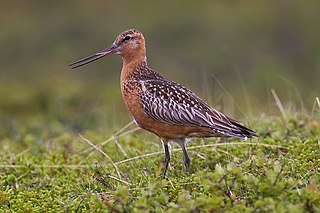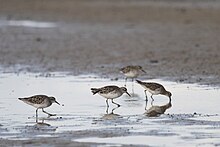
The sanderling is a small wading bird. The name derives from Old English sand-yrðling, "sand-ploughman". The genus name is from Ancient Greek kalidris or skalidris, a term used by Aristotle for some grey-coloured waterside birds. The specific, alba, is Latin for "white".

The dunlin is a small wader, formerly sometimes separated with the other "stints" in the genus Erolia. The English name is a dialect form of "dunling", first recorded in 1531–1532. It derives from dun, "dull brown", with the suffix -ling, meaning a person or thing with the given quality.

The little stint is a very small wader. It breeds in arctic Europe and Asia, and is a long-distance migrant, wintering south to Africa and south Asia. It occasionally is a vagrant to North America and to Australia. The genus name is from Ancient Greek kalidris or skalidris, a term used by Aristotle for some grey-coloured waterside birds. The specific minuta is Latin for "small.

The least sandpiper is the smallest shorebird. The genus name is from Ancient Greek kalidris or skalidris, a term used by Aristotle for some grey-colored waterside birds. The specific minutilla is Medieval Latin for "very small".

The red knot or just knot is a medium-sized shorebird which breeds in tundra and the Arctic Cordillera in the far north of Canada, Europe, and Russia. It is a large member of the Calidris sandpipers, second only to the great knot. Six subspecies are recognised.

The western sandpiper is a small shorebird. The genus name is from Ancient Greek kalidris or skalidris, a term used by Aristotle for some grey-coloured waterside birds. The specific mauri commemorates Italian botanist Ernesto Mauri (1791–1836).

The white-rumped sandpiper is a small shorebird that breeds in the northern tundra of Canada and Alaska. This bird can be difficult to distinguish from other similar tiny shorebirds; these are known collectively as "peeps" or "stints".

Baird's sandpiper is a small shorebird. It is among those calidrids which were formerly included in the genus Erolia, which was subsumed into the genus Calidris in 1973. The genus name is from Ancient Greek kalidris or skalidris, a term used by Aristotle for some grey-coloured waterside birds. The English name and specific bairdii commemorate Spencer Fullerton Baird, 19th-century naturalist and assistant secretary of the Smithsonian Institution.

The long-billed dowitcher is a medium-sized shorebird with a relatively long bill belonging to the sandpiper family, Scolopacidae. In breeding plumage, adults are characterized by a beautiful rufous head and underparts with a darker mottled back and a large white upper rump only seen in flight. They feed in various freshwater habitats with their bill underwater in a "sewing machine" motion and are known to have an exciting mating display where males chase females in flight. The genus, Limnodromus is Ancient Greek from limne, "marsh" and dromos, "racer". The specific scolopaceus is Neo-Latin for "snipe-like", from Latin scolopax, scolopacis, a snipe or woodcock. The English name is from Iroquois and was first recorded in 1841.

The bar-tailed godwit is a large and strongly migratory wader in the family Scolopacidae, which feeds on bristle-worms and shellfish on coastal mudflats and estuaries. It has distinctive red breeding plumage, long legs, and a long upturned bill. Bar-tailed godwits breed on Arctic coasts and tundra from Scandinavia to Alaska, and overwinter on coasts in temperate and tropical regions of Australia and New Zealand. The migration of the subspecies Limosa lapponica baueri across the Pacific Ocean from Alaska to New Zealand is the longest known non-stop flight of any bird, and also the longest journey without pausing to feed by any animal. The round-trip migration for this subspecies is over 29,000 km (18,020 mi).

The ruff is a medium-sized wading bird that breeds in marshes and wet meadows across northern Eurasia. This highly gregarious sandpiper is migratory and sometimes forms huge flocks in its winter grounds, which include southern and western Europe, Africa, southern Asia and Australia.

The red-necked stint is a small migratory wader. The genus name is from Ancient Greek kalidris or skalidris, a term used by Aristotle for some grey-coloured waterside birds. The specific ruficollis is from Latin rufus, "red" and collum, "neck".

The curlew sandpiper is a small wader that breeds on the tundra of Arctic Siberia.

The broad-billed sandpiper is a small wading bird. The scientific name is from Latin. The specific name falcinella is from falx, falcis, "a sickle. Some research suggests that it should rather go into the genus Philomachus.

The long-toed stint is a small wader. The genus name is from Ancient Greek kalidris or skalidris, a term used by Aristotle for some grey-coloured waterside birds. The specific subminuta is from Latin sub, "near to" and minuta, "small" from its similarity to the little stint, Calidris minuta.

The great knot is a small wader. It is the largest species of the genus Calidris. They are a migratory bird which breeds in Siberia, Russia, and flies to southern Asia and Australia in the northern winter.

Calidris is a genus of Arctic-breeding, strongly migratory wading birds in the family Scolopacidae. These birds form huge mixed flocks on coasts and estuaries in winter. Migratory shorebirds are shown to have decline in reproductive traits because of temporal changes of their breeding seasons(Weiser et al., 2018). They are the typical "sandpipers", small to medium-sized, long-winged and relatively short-billed.

The pectoral sandpiper is a small, migratory wader that breeds in North America and Asia, wintering in South America and Oceania. It eats small invertebrates. Its nest, a hole scraped in the ground and with a thick lining, is deep enough to protect its four eggs from the cool breezes of its breeding grounds. The pectoral sandpiper is 21 cm (8.3 in) long, with a wingspan of 46 cm (18 in).

The stilt sandpiper is a small shorebird. The scientific name is from Ancient Greek. The genus name kalidris or skalidris is a term used by Aristotle for some grey-coloured waterside birds. The specific himantopus means "strap foot" or "thong foot".
Cox's sandpiper is a hybrid between a male pectoral sandpiper and a female curlew sandpiper. First discovered in Australia in the 1950s, it was originally described as a species new to science and named after Australian ornithologist John B. Cox. However, it was later found to be a hybrid. Most if not all birds found to date are males, in accord with Haldane's rule.























